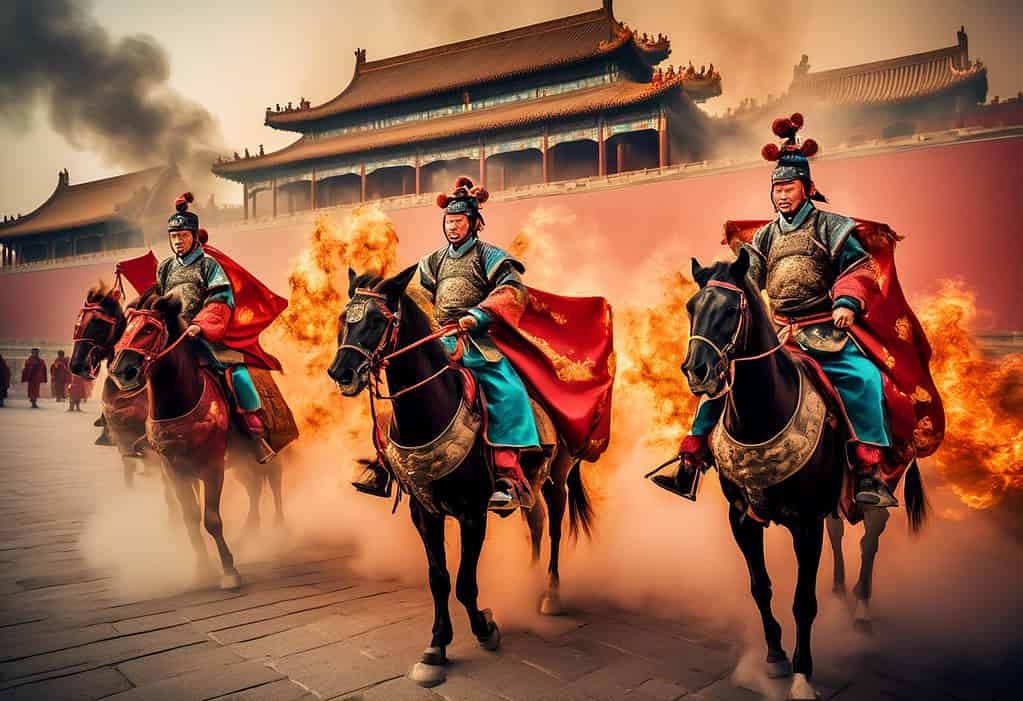The Qing Dynasty was a Chinese dynasty that ruled from 1644 to 1912 CE. It was the last imperial dynasty of China. The dynasty was established by the Manchu people, who invaded China and overthrew the Ming Dynasty. The Qing Dynasty was known for its military conquests and expansion of territory. It was also a time of great cultural and economic prosperity in China. The dynasty ended with the Xinhai Revolution in 1912, which led to the establishment of the Republic of China.
Summary List
- The Qing Dynasty was the last imperial dynasty in Chinese history, ruling from 1644 to 1912 CE.
- The Qing Dynasty was founded by the Manchus, a group of people from Manchuria in northeast Asia.
- The Qing Dynasty expanded China's territory to its largest extent, including Tibet, Xinjiang, and Mongolia.
- The Qing Dynasty is known for its strict social hierarchy, with the emperor at the top and scholars, farmers, artisans, and merchants below.
- The Qing Dynasty fell in 1912 due to a series of rebellions, revolutions, and foreign invasions, leading to the establishment of the Republic of China.
Games And Apps
Learning Modules
The Manchu Conquest - 1644 CE
In 1644, the Manchu conquered China, ending the Ming dynasty and establishing the Qing dynasty. Through military conquest and political maneuvering, the Manchu rulers reshaped Chinese society and culture. The Manchu Conquest of 1644 CE marked a turning point in Chinese history, with lasting effects on the country's future.
I Want To Learn This!Reign of the Kangxi Emperor - 1661 CE
Reign of the Kangxi Emperor - 1661 CE: Step into the opulent court of China's Kangxi Emperor, a powerful ruler who reigned for over six decades. Discover the intrigue, power struggles, and cultural advancements of this golden age in Chinese history.
I Want To Learn This!The Dzungar Wars - 1687 CE
The Dzungar Wars were a series of bloody conflicts between the Qing Dynasty of China and the Dzungar Khanate of Mongolia from 1687 to 1758. Fought over control of the Silk Road trade route and territory in Central Asia, the wars resulted in massive loss of life and cultural destruction.
I Want To Learn This!Treaty of Nerchinsk - 1689 CE
The Treaty of Nerchinsk, signed in 1689, marked the end of centuries of border disputes between the Russian Empire and the Qing Dynasty of China. This landmark agreement established the first official border between the two empires and set the stage for future diplomatic relations in East Asia.
I Want To Learn This!The Yongzheng Era - 1722 CE
In 1722 CE, the Yongzheng Era began in China, marked by the reign of Emperor Yongzheng. Known for his efforts in stabilizing the Qing Dynasty and implementing reforms to strengthen the empire, this period was characterized by economic prosperity, cultural advancements, and political intrigue.
I Want To Learn This!The Qianlong Emperor's Golden Age - 1735 CE
In 1735, the Qianlong Emperor ascended to the throne of the Qing Dynasty, ushering in a golden age of prosperity and cultural advancement. Under his rule, China experienced unprecedented economic growth, military expansion, and artistic innovation. Discover the incredible legacy of one of China's greatest rulers in The Qianlong Emperor's Golden Age - 1735 CE.
I Want To Learn This!First Opium War - 1839 CE
The First Opium War of 1839 saw the clash between China's Qing Dynasty and the British Empire over the lucrative opium trade. Triggered by tensions over trade imbalances and China's ban on opium, the conflict resulted in British victory and the signing of the Treaty of Nanking in 1842.
I Want To Learn This!Taiping Rebellion - 1850 CE
The Taiping Rebellion, which began in 1850, was a massive civil war in China that lasted for over a decade. Led by Hong Xiuquan, a self-proclaimed prophet, the rebellion aimed to overthrow the ruling Qing dynasty and establish a utopian society based on Christian principles.
I Want To Learn This!Second Opium War - 1856 CE
The Second Opium War, also known as the Arrow War, was a conflict fought between the British Empire and the Qing dynasty of China from 1856 to 1860. Sparked by tensions over the opium trade and Western influence in China, the war resulted in a humiliating defeat for the Qing dynasty.
I Want To Learn This!Boxer Rebellion - 1899 CE
In 1899, the Boxer Rebellion erupted in China as a violent anti-foreign and anti-Christian uprising. The Boxers, a secret society, targeted Westerners and Chinese Christians, resulting in widespread bloodshed and destruction. The conflict ultimately led to the intervention of an international coalition force and the suppression of the rebellion.
I Want To Learn This!The Xinhai Revolution - 1911 CE
The Xinhai Revolution of 1911 marked the end of the Qing dynasty and the beginning of a new era in China. Led by revolutionaries like Sun Yat-sen, the uprising aimed to overthrow the imperial system and establish a republic. This pivotal moment in Chinese history forever changed the course of the nation.
I Want To Learn This!












